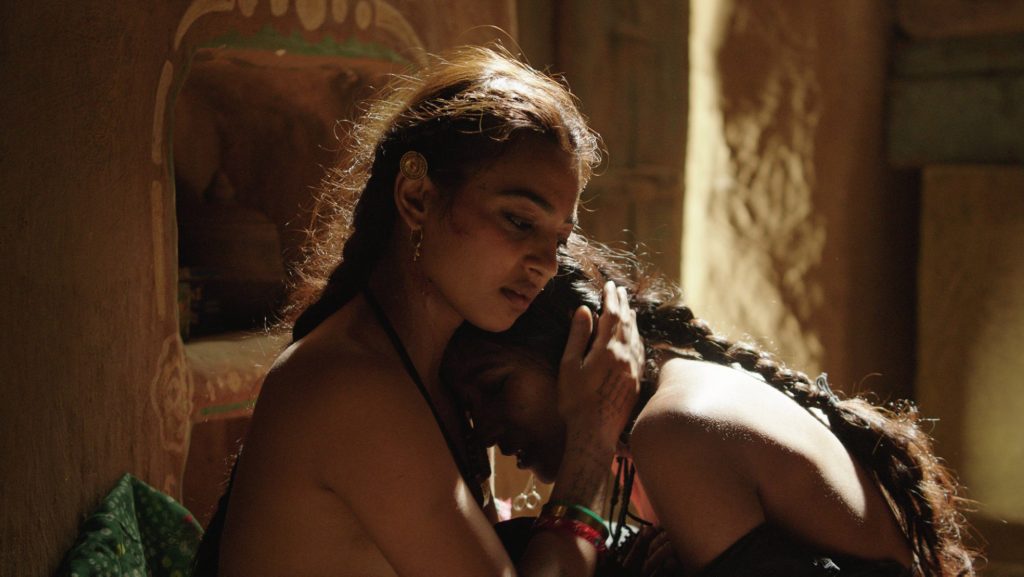Parched is a story about four women of different ages but similar geographical backdrops who find themselves trapped in diverse ways in a criminally patriarchal world. Are they aware of the tragedy of their lives? Or do they continue to live with the pain and the humiliation their entire life? It is a story that unfolds alternately with doses of fun, biting satire, humor, irony and a lot of sex and sexual innuendo.
Rani (Tannishtha Chatterjee), widowed at 15, is in her thirties and has a 17-year-old son, Gulab (Riddhi Sen). Lajjo (Radhika Apte) is married to Madan, an alcoholic and a womanizer. He uses sex not as a fulfillment of his physical hunger but as a weapon of torture on his wife, who is childless and is punished for being so. Janaki (Lehar Khan), 14, is married off to Gulab for which Rani pays a dowry of Rs 4 lakh by mortgaging her small hut-like home. Bijlee (Surveen Chawla) is an item dancer in the touring circus that strikes tent in the village who also entertains customers at night for a fee.
Parched, directed by Leena Yadav and presented by Ajay Devgn, is a powerful feminist statement against patriarchy that defines a woman’s life, its double-edged title as sharp as a knife that cuts both ways. On the one hand, it establishes the identity of the village in Rajasthan the women live in, while on the other, it refers to the desperate thirst in their lives – a thirst for love, for a sense of belonging, for sex as it should be, for dignity and for roots within these parameters of life. Their lives are dry because of the climatic feature of the space they live in represented both by the geography and the men in the village.
The time the story is set in is not described but one assumes that it is a contemporary situation that sustains till this day in parts of the country of which Rajasthan is just a microcosm. Every single character is fleshed out fully and the women are distinct by nature, responsibility and degree of torture and humiliation that takes an unusual and dramatic twist when the four women discover, through their wonderfully orchestrated bonding, that there actually lies a different life for them beyond the horizon. They pool in their money to buy the village its first television set and yet, when the time comes to cut the ceremonial ribbon, the male panchayat elder does the honors. Lajjo’s story is the most radical among the four and this takes the film to a slightly melodramatic but nail-biting climax during the burning of Ravana at Dussehra.
The dialogue is full of sexual innuendo mainly indulged in by the women led by Bijlee. In one scene, she even asks, “Why should every expletive be prefixed by words like ‘mother’, ‘sister’ etc? Why not invent new ones with men as prefixes such as “fatherf…..r”, “brotherf….r’ ourselves?” She leads Rani and Lajjo to a hilltop and the three shout out their own expletives deriving their own joy out of it. Another touching symbol is the kitsch-art decorated three-wheeler Bijlee rides away freely on without the permission of her boss. It has two wide wings in front that stands for freedom from every kind of social and emotional bondage and adds another dimension to the film’s mood. Then there is a mysterious ‘Shahrukh Khan’ who wants to send a Valentine’s Day message to Rani and keeps calling her without identifying himself. The sex scenes are delicately handled and neither hurt the sensibilities of the viewer nor do they appear forced or sensational.
Apart from the uniformly fine performances of the cast, Russell Carpenter’s cinematography is one of the highlights of the film in its use of light, color, shade and darkness, specially against the wide expanse of the desert landscape placing the characters in perspective. The hues of Rajasthan are captured beautifully in the lighting of the tent with the dance shows, the décor of the huts, the red chillies spread out to dry in the sun juxtaposed against the dark interiors of the cave and the shimmering waters of a small water space where within a brief collage of sequences, Lajjo’s life changes forever. The music and the songs go well with the changing moods of the film. The production design, art direction and costume design is just apt. If one takes a closer look at the script, one may discover layers of cinematic coincidences and touches of melodrama but they are made to jell seamlessly into the main narrative.
What happens to the mysterious ‘Shah Rukh Khan’? For that, you must watch the film. It is both riveting and powerful, continuing the trend of using cinema to make incisive comments on how the female of the species need to empower themselves with the inner strength they can always draw upon to make their own rules and break old ones.
Hindi, Drama, Color



great Movie Parched. All Actors do well in the movie.